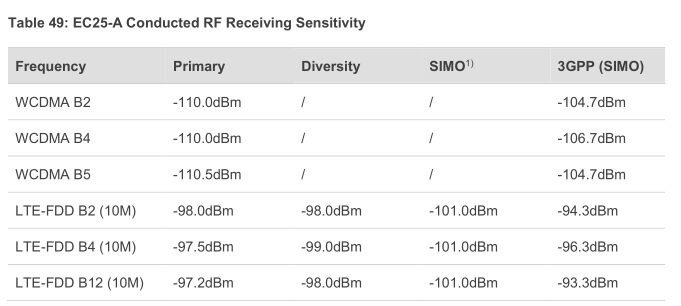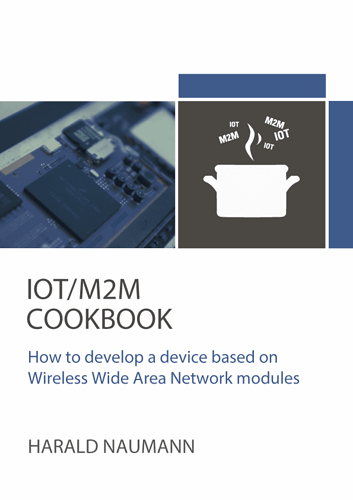I have been testing Quectel EC25-A, EC25-V and EC25-AF modules and find their ability to connect and stay connected in weak signal areas is poor.
I have one other module, a DW5804 (Expedite E371) made by Novatel. The Novatel can connect - and stay connected in areas where the Quectel cannot.
My setup:
Raspberry pi 3B+, Raspberry pi 4B+ (2GB)
Raspbian - latest
SixFab mini PCIe “hat”
SixFab provided QMI interface software
Quectel EC25-X modules
T-Mobile (USA) SIM card
Antenna - 4G multiband antenna - specs below
-
 High Gain: This 9 dBi SMA stick antenna can increases the range of your wireless device.
High Gain: This 9 dBi SMA stick antenna can increases the range of your wireless device.
-
 Dual-band: With high value Dual-band antennas you can get maximum omnidirectional wireless coverage and reliability
Dual-band: With high value Dual-band antennas you can get maximum omnidirectional wireless coverage and reliability
-
 Application: Devices with SMA connector interface, Verizon, AT&T, Sprint, T-Mobile, and all 3G, 4G, LTE,GSM & CDMA cellular services, Wireless Network Router/USB Adapter/PCI PCIe Cards/IP Camera, etc.
Application: Devices with SMA connector interface, Verizon, AT&T, Sprint, T-Mobile, and all 3G, 4G, LTE,GSM & CDMA cellular services, Wireless Network Router/USB Adapter/PCI PCIe Cards/IP Camera, etc.
Only ONE antenna was used for the tests. The setup was done by the SixFab configuration file, which was written to support the Quectel. NO CHANGE to any software was performed when changing to the Novatel card.
My home is located in an area with relatively poor T-Mobile signal strength. Exactly the same setup was used for both cards.
The Quectel modems will usually not connect. If they do, they do not usually stay connected for more than a few minutes before they lose connection.
The Novatel modem usually DOES connect, and while the PING times (to 8.8.8.8) are over 100mSec, it still does work. And it stays connected.
The Novatel uses a Qualcomm chipset, I don’t know what Quectel is using, but it does not work as well as the Novatel.
I did not try the throughput in strong signal areas. Perhaps there is a difference there. I need > 6Mb/sec up and 5Mb/sec down - guaranteed.
Hi Charles,
EC25 module was used Qualcomm chipset 9x07. Its Receiving Sensitivity as below:


For your issue, please contact our North America FAE directly.
He will give you strong support for this case. Thank you.
I have emailed Wade Zhang, but have not yet received a reply. I have tried several antennas, but still find the sensitivity is NEVER as good as a cell phone on the same service. Could it be that the PCB layout on the Quectels is not optimized ?
I feel that a module with a decent antenna should ALWAYS be able to connect to a signal better than a cell phone with no external antenna.
Hi Charles,
First, I should clarify that, the issue may be related to platform,antenna,test channels and signal.
- Could you please tell us which platform does Novatel use?
- Is it tested with the same antenna?Can you provide photos of the two modules antennas?
- Did you test the two modules with the same channels and did you query the signal strength?
- Could you please grab the QWINlog to us for analysis?
Before grabbing QWINLOG, you need to send AT+QCFG=“DBGCTL”,0 to enable.
And when you grab the QWINLOG, you also need to grab AT log.
The QWINLOG user guide is also in the link below:
https://cnquectel-my.sharepoint.com/:f:/g/personal/europe-fae_quectel_com/Evd7pIzzpXJHrUimfJmLtEcBDApNKxJghWe4bqKLL-2N9Q?e=18sRTi
TRP and TIS measurement
Many modern wireless specifications require the Total Radiated Power (TRP) and Total Isotropic Sensitivity (TIS) of a wireless device to comply to a certain class of devices. The TRP is measured by measuring the radiated power at many points around the device and sum the values to the total power radiated. The TIS measurement is similar but a lot more involved because the sensitivity must be measured at many points. Not only does the measurement need to ‘speak’ the protocol but the determination of sensitivity for each measurement point takes a lot more time. Read more:
Even with a perfect antenna, most people fail the TIS. At TIS, PTCRB checks how well the IoT device is receiving. But your Rasberry PI will generate a high noise level. The EC25 cannot receive an LTE signal if the Rasberry PI’s interference signal is greater than -110 dBm. Take the spectrum analyzer and measure the signal level in your lab.
More about TRP and TIS also in my IoT / M2M Cookbook: [http://www.gsm-modem.de/M2M/m2m_iot_cookbook/](http://www.gsm-modem.de/M2M/m2m_iot_cookbook/
 High Gain: This 9 dBi SMA stick antenna can increases the range of your wireless device.
High Gain: This 9 dBi SMA stick antenna can increases the range of your wireless device. Dual-band: With high value Dual-band antennas you can get maximum omnidirectional wireless coverage and reliability
Dual-band: With high value Dual-band antennas you can get maximum omnidirectional wireless coverage and reliability Application: Devices with SMA connector interface, Verizon, AT&T, Sprint, T-Mobile, and all 3G, 4G, LTE,GSM & CDMA cellular services, Wireless Network Router/USB Adapter/PCI PCIe Cards/IP Camera, etc.
Application: Devices with SMA connector interface, Verizon, AT&T, Sprint, T-Mobile, and all 3G, 4G, LTE,GSM & CDMA cellular services, Wireless Network Router/USB Adapter/PCI PCIe Cards/IP Camera, etc.

